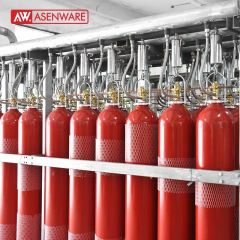GAS-BASED FIRE EXTINGUISHING SYSTEMS
They are clean systems that do not cause residues when extinguishing, avoiding damage to materials, instrumentation, electronic and electrical equipment. In recent times, gas fire extinguishing systems have evolved and eliminated the use of halon as an extinguishing agent, replacing it with clean gaseous agents that comply with the Kyoto protocol, being harmless to the ozone layer.
Existing systems
There are different types of gaseous extinguishing agents, which will be selected according to the possible nature of the fire, the risk to be protected or the possibility of personnel in it:
- CO2 SYSTEM (Carbon Dioxide)
- FM-200 SYSTEM (HFC227ea or hepta-fluoro-propane)
- INERGEN SYSTEM (Composed of gases: Argon, nitrogen and carbon dioxide)
Fire extinguishing agent
The discharge of the extinguishing agent will cause a reduction in the initial oxygen concentration, an increase in pressure in the room, formation in the presence of fire of decomposition products and a reduction in temperature.
Gas Fire Extinguishing
The most suitable risks for the protection of fires with gases are: electrical equipment, computer rooms, telephone equipment, electricity generators, rotary printing machines, paint rooms, paper and data files.
They can act mainly by total flooding, or localized protection depending on the case, and the extinguishing agent.
Localized protection is called when the risk to be protected is in an open space, considering then hypothetical volumes and additional gas discharges, and a direct discharge focused on the risk, in order to achieve a rapid suffocation of the same.
Total Flood, is the protection of a closed space, having to achieve concentrations and discharge times determined by standards, varying them depending on the risk to be protected and the extinguishing agent selected.
The main gaseous extinguishing agents are: Inert Gases, Carbonic Anhydrous CO2 and Clean Gases HFC - 227ea (FM200)
Clean Gases HFC 227ea (Trade Name FM200)
Its extinguishing action is based on breaking the chain reaction of fire by extinguishing the heat energy of combustion.
Its discharge time must be 10 seconds maximum, so its extinction time is immediate, which added to its property of not being harmful to people and that of not being harmful to electronic equipment, it is ideal to protect this type risk.
The systems that use clean gases to extinguish fires are especially indicated to protect sensitive assets, since after extinguishing the loss, they do not leave residues or damage the protected products.
Anhydrous Carbonic CO2
Its extinguishing action is based on the displacement of oxygen, requiring design concentrations and discharge times appropriate to each risk and each system. It is stored in cylinders at high pressure, in liquid form, so the design of the distribution pipes and peak orifices of the discharge nozzles will be such as to allow the liquid state of the carbon dioxide to be maintained until the discharge peak where just gasified.Taking into account that the concentrations are high, the amount of gas that is needed for the extinction is usually important, the costs of equipment increase, although the cost of the gas is low.
Special attention must be paid to the occupation of people in the enclosures to be flooded, because the concentrations are lethal, having to generate pre-alarms, interlocks, or devices that ensure the evacuation of people before the discharge occurs. Taking into account that the concentrations are high, the amount of gas that is needed for the extinction is usually important, the costs of equipment increase, although the cost of the gas is low. Special attention must be paid to the occupation of people in the enclosures to be flooded, because the concentrations are lethal, having to generate pre-alarms, interlocks, or devices that ensure the evacuation of people before the discharge occurs.
FEATURES
Safe for personnel and equipment. It leaves no residue behind and is environmentally friendly. Most systems are designed to extinguish fires in one minute.
TECHNICAL SPECIFICATIONS
Actuation by solenoid or manual actuator. Stored as a gas within the cylinder assembly.
Gas fire extinguishing systems What types of extinguishing agent exist?
When a fire spreads, there are sometimes situations in which extinguishing media of dust or water are not the most suitable, as it could cause serious material damage. In these cases, the fire-fighting gas system is used.
The systems of fire - extinguishing gases are clean systems that do not cause damage or electrical materials. In recent years they have evolved notably: they are not harmful to the environment and comply with the Kyoto protocol.
These fire protection systems are used by means of fixed extinguishing installations, based on gaseous agents that provide fire protection for human life and material goods. The main technique of gas firefighting systems is based on reducing the concentration of CO 2 and absorbing heat.
Gas fire extinguishing systems are especially suitable for areas composed of liquid fuels or other materials that behave similarly when there is fire, and for areas containing equipment or high-value objects that can be damaged if other types are used. of fire extinguishers.
When a fire is detected in a space protected by a gas extinguishing system, the extinguishing unit sends a signal, usually electrical, which allows automatic activation of the extinguishing system. There are different types of extinguishing agents, and depending on the type of fire or the burned area, one or the other is used.
Gas fire extinguishing systems
Firefighting gas: Carbonic Anhydride CO 2
- They put out the fire by reducing the amount of oxygen to levels where combustion cannot be sustained.
- They are dangerous for people; therefore, it is not recommended for extinguishing fires with occupation of people.
- They are stored as liquefied gases.
- They are used in fire and electrical hazards.
- They need high concentrations.
Firefighting gas: Inert gases
- The oxygen in the air is displaced until the oxygen concentration is no longer high enough to allow combustion.
- They do not produce chemical combinations or compositions.
- They produce a clean extinguishing without residue.
- They require high concentrations.
- They are stored as compressed gases under pressure.
- They are used in electrical hazards where it is not possible to clean protected goods, unoccupied areas.
Firefighting gas: Fluorinated Gases (HFC's)
- They are used directly against fire.
- They need relatively low concentrations
- They put out the fire by cooling the flame
- They are stored as liquefied gases
- They are used in electrical irrigation where it is not possible to clean protected goods, in occupied areas (they have a low toxicity for people)
- They are harmful to the ozone layer, contributing to the greenhouse effect.
Which gas is used for fire suppression?
Inert gas suppression systems use argon and nitrogen gases and their mixtures as an extinguishing agent and are based in the principle of reducing the oxygen concentration inside the protected hazard.
How does a gas fire suppression system work?
Fire suppression systems extinguish electrical fires by releasing a concentration of gas within a particular room, removing the oxygen and extinguishing the fire. Most commonly found in server rooms, computer suites and communication rooms, a Gas Suppression system protects the integral functions of your business.
How much Gas Fire Suppression price in Bangladesh?
Gas Fire Suppression price in Bangladesh ranged from BDT 850,00.00 to 750,000.00. The price variation depends on specification, quality and Brand.
Who is the best supplier, Importer and installer for Gas Fire Suppression in Bangladesh?
Germany Computer and Telecom Ltd is the best supplier, Importer and installer for Gas Fire Suppression in Bangladesh with many years of experience.







